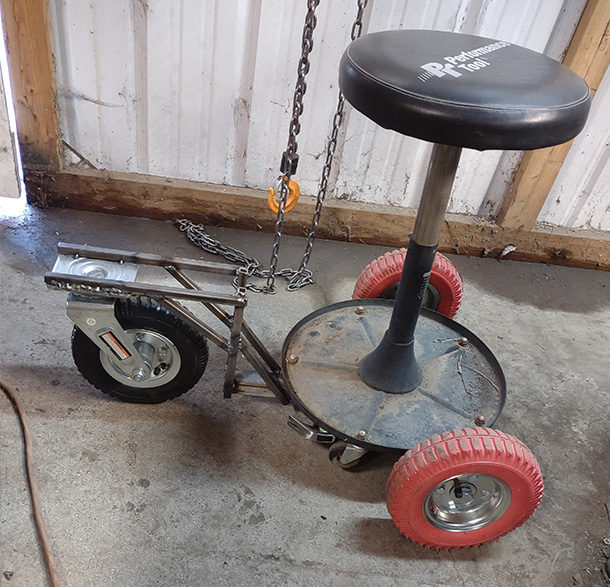“Hey, man, I’m watching videos,” was the answer I gave when the cord from my welding hood to my jacket pocket was questioned. Knowing I was looking at an extended welding project in cold weather, I was dreading the accompanying fogging of welding hood lens and glasses. Constant mouth exhaling, blowing air up over the lens helped. Some.
Everything I found to address this was either overkill (welding hoods filtering and blowing clean air, for use in toxic environments) or more expensive than my budget. Knowing computers used small fans for cooling, I did some online searching. Twelve-volt DC current-powered squirrel cage fans about the size of a Mason jar cap were available. I had cordless power tools that were 12-volt, so I sprang for a mini-fan.
On arrival, I found that it fit nicely on a flat surface inside my favorite welding hood with the exit port aimed at the glass shield I looked through while welding. I used the “smoke and hot wires” method to identify the positive and negative anodes on the battery. Nothing smoked. Connected one way, nothing happened. The other way, and the little fan turned robustly and almost silently. I labeled the battery and the connector plugs.
A little spot of clear RTV silicone anchored the fan unit in place. I ran the wires around the edge of the welding hood and covered them with camo duct tape that kind of matches the hood (see picture). I found a simple two-pin connector plug and found a small rocker switch among my plunder. For a cord, I found the coiled cord from a (now antique) landline phone. I mated spade plugs on one end and the two-pin plug on the other, using the color coding of the tiny wires inside to ensure the positive stayed positive and the negative stayed negative.
I was ready to “smoke test” it. It did not interfere with my glasses – and with my hearing aids set for normal conversation, I couldn’t hear it running. I could feel a movement of air. Welding in an environment that had been the worst for lens and glasses fogging, I was amazed. Why had I not done this before?
Most readers know that our oldest son was born with arthrogryposis. Translated from the Greek, it means tight, twisted joints. He’s missing most of the muscle mass in his arms and upper body as well as joints that don’t move as needed. He was 3 before he took his first unaided step. By 10 he was riding a bicycle (scaring the stuffing out of Mom and Dad) and ran cross country in high school.
Note that arthrogryposis can be mild or severe, and no two patients should ever judge their own or another’s abilities or disabilities against someone else’s.
The rule for help was: Mitch had to try everything by himself before he got any help doing things. My dad got him a plastic horse on wheels before he was walking. It fit. Feet on the floor and his weight on the seat, and his hands could reach the handholds near “Horsy Pete’s” ears. The boy was scared, then thrilled. He could move about by himself. Then the inevitable first tumble. As he lost his balance and rolled off, Mitch lifted a foot and booted Horsy Pete in the butt as it rolled away.
I credit a fair amount of my mechanical ingenuity to helping Mitch alter things so they work for him. A coaster brake on a bike won’t work. But a caliper brake on the rear wheel will, as long as the control handle for it is attached to the rear frame of the bike so Mitch can press it with his heel to slow and stop the bike.
Our current project is a rough-terrain stool base. Mitch joined a swing dance group and uses a stool on oversized rollers to accomplish the spins and all the dancing. But it still doesn’t roll easily on a sidewalk. We’re finishing a three-wheeler with one 8-inch crazy wheel front and two the same size in the rear (see picture). We can see it giving Mitch the freedom to “go downtown” or to the mall without constantly factoring in the distance to places to sit down.
A few weeks back, discussing things we’d made or altered, Mitch said, “When someone is helping me with something and I make a suggestion and they say it can’t be done … I realize that I’m talking to the wrong person.”











